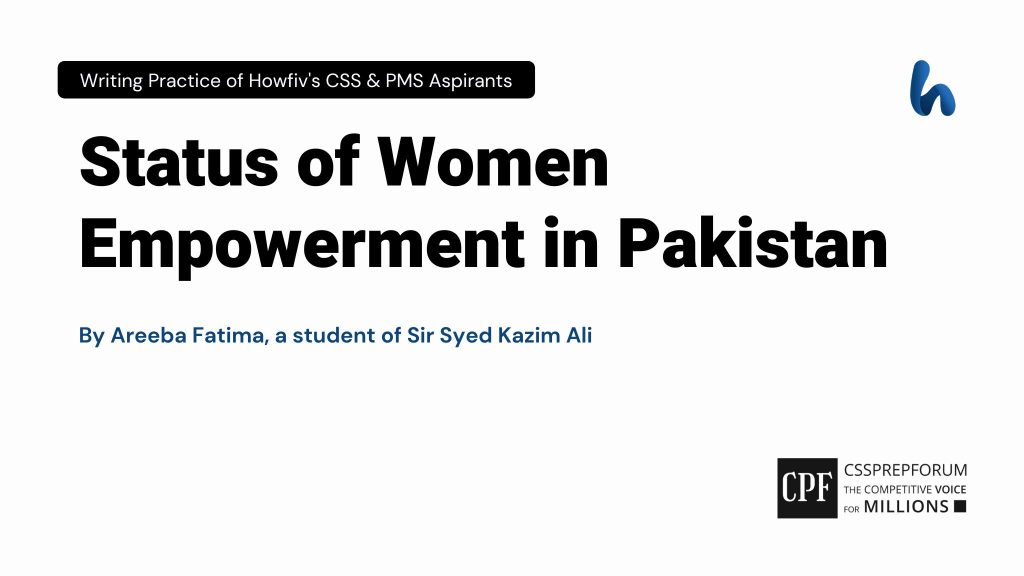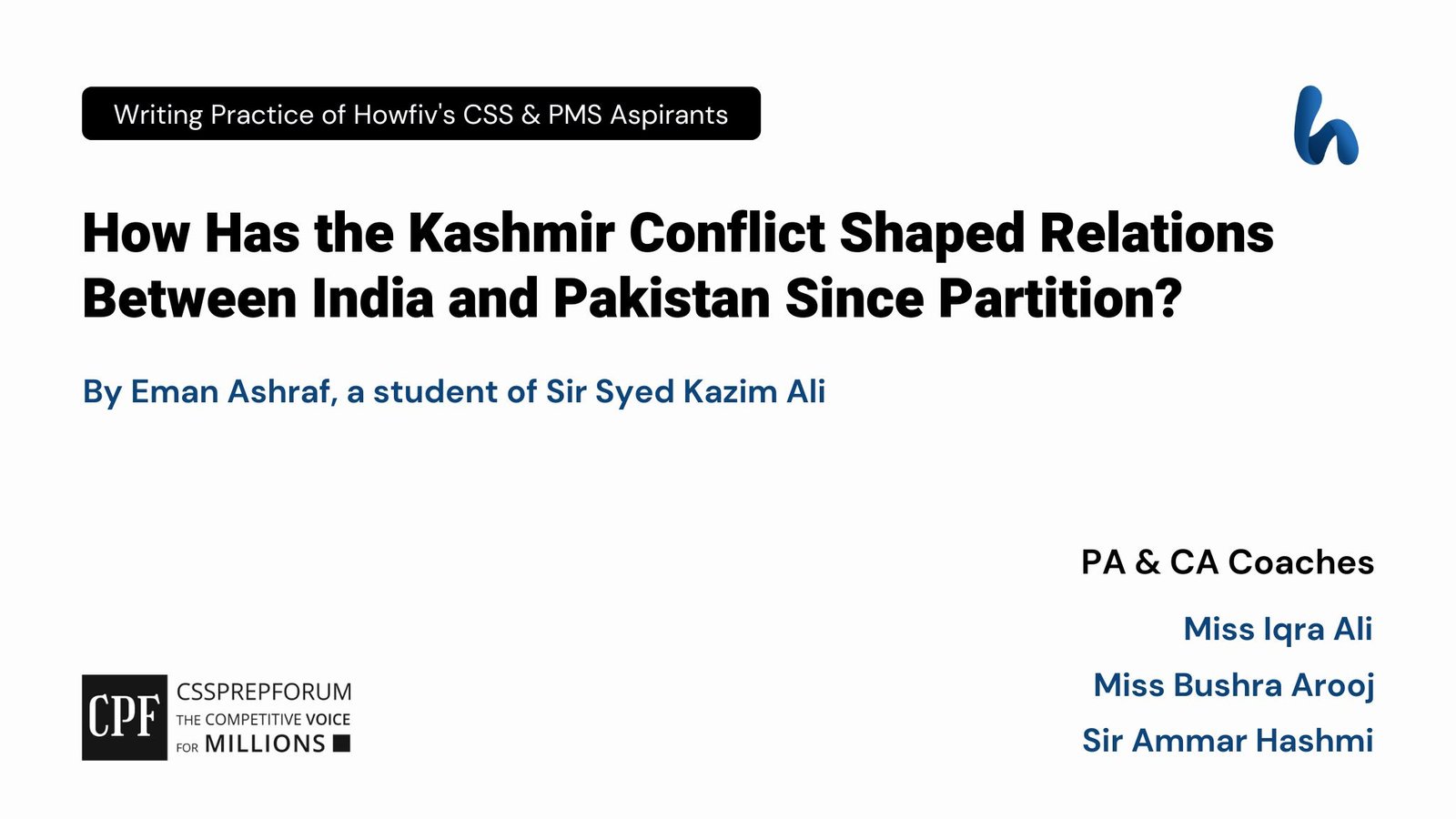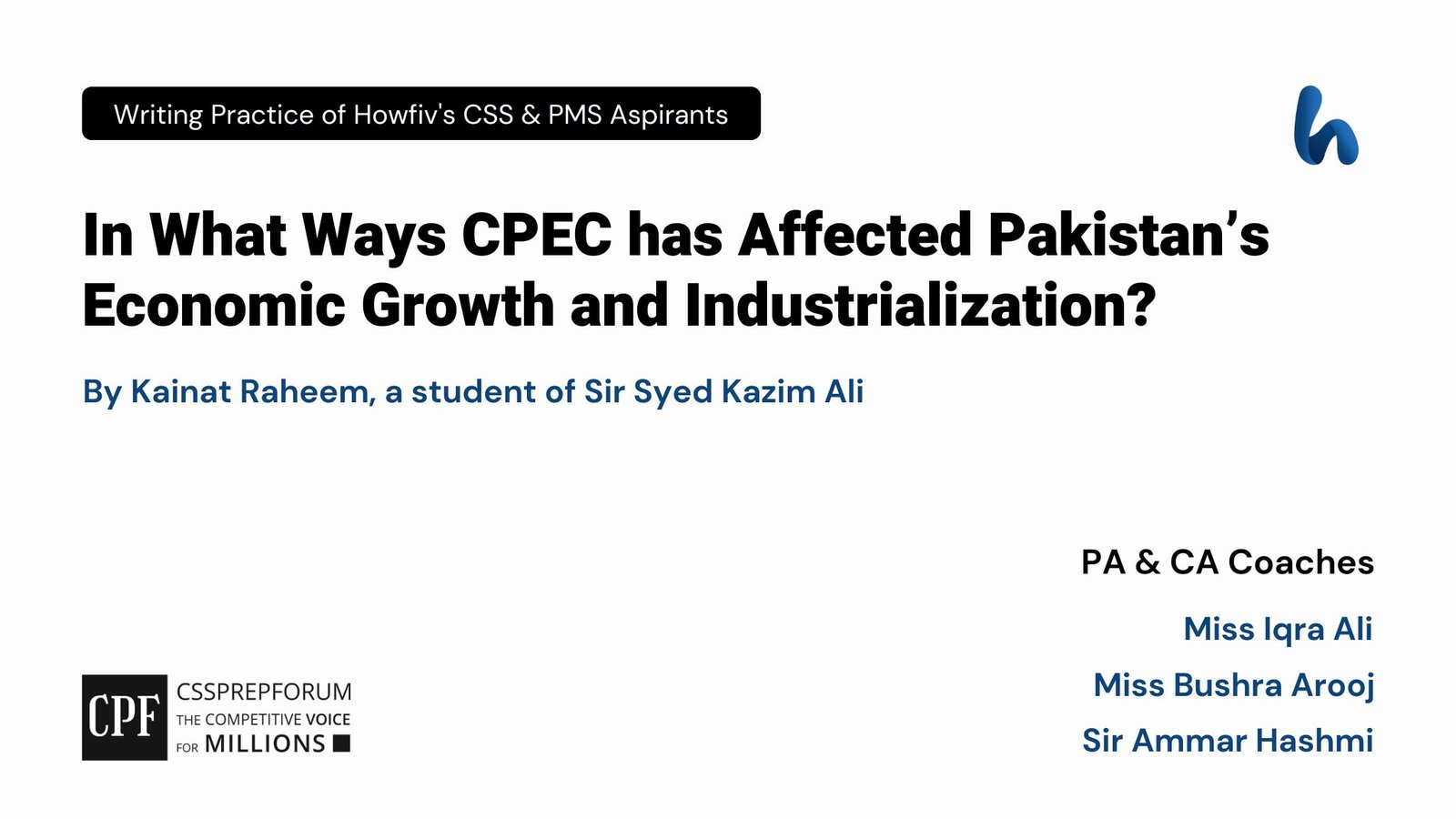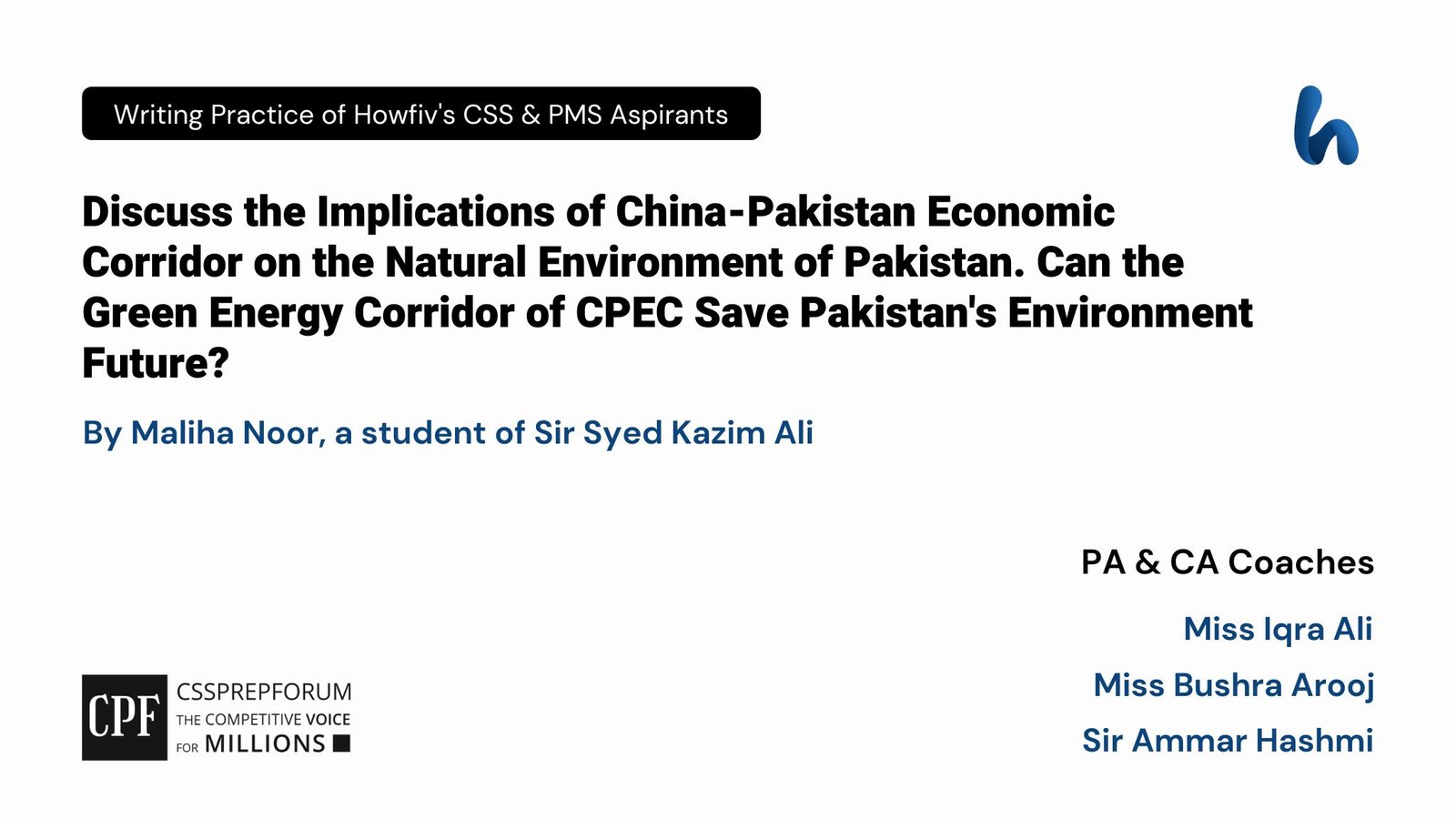Status of Women Empowerment in Pakistan | Daily Writeups | Opinions
The following article, “Status of Women Empowerment in Pakistan“, is written by Areeba Fatima, a student of Sir Syed Kazim Ali. Moreover, the article is written on the same pattern, taught by Sir to his students, scoring the highest marks in compulsory subjects for years. Sir Kazim has uploaded his students’ solved past paper questions so other thousands of aspirants can understand how to crack a topic or question, how to write relevantly, what coherence is, and how to include and connect ideas, opinions, and suggestions to score the maximum.

Women empowerment is not just a mere concept; it is the key to unlocking the full potential of half of the world’s population. The world cannot progress and prosper if women are not given equal opportunities and rights as men. Although women have been suppressed and oppressed for centuries under the guise of patriarchal and stereotypical norms of society, countries across the globe have realized the importance of women’s empowerment. They are taking measures to provide equal autonomy to women in economic and political decision-making. However, developing countries like Pakistan still have a long way to go regarding women’s empowerment. Pakistan ranks 145 out of 146 countries on the Global Gender Gap Report 2022, which is alarming and unacceptable. Women in Pakistan face numerous obstacles to availing their due rights, and it is the country’s responsibility to help them break free from these obstacles and empower them.

Talking about women’s empowerment, it is a multidimensional concept encompassing various aspects, including social, psychological, economic, political, cultural, religious, personal, and emotional dimensions. It is not just about equal access to material resources such as land, money, and job opportunities. Still, it is also about ensuring women’s representation in political and decision-making bodies, granting them fundamental rights, the freedom to make choices in life, and equal access to health facilities. Empowering women is not just about achieving gender equality but is also instrumental in promoting a better economy, society, and nation. Women’s empowerment can lead to sustainable economic development, social prosperity, and, ultimately, the progress of the entire world. Therefore, we must work towards women’s empowerment and provide them with equal opportunities and rights to unleash their full potential.
Moving ahead, the status of Gender Equality and Women’s Empowerment (GEWE) in Pakistan has evolved gradually, considering their significant contribution to sustainable socio-economic development. However, much more needs to be done to empower women in all sectors, as the situation of women’s empowerment is deplorable. To explain, a snapshot of the status of women’s empowerment in Pakistan is given below. To begin with, women’s right to healthcare and well-being is frequently confronted with a myriad of socio-cultural factors in Pakistan. Specifically, women face particular constraints in accessing women-specific healthcare services that negatively impinge upon women’s health and physical well-being. Moreover, the health issues in Pakistan range from the highest maternal mortality rate among women to the burgeoning cases of breast cancer and iron deficiency. According to the United Nations report, 48 per cent of women in Pakistan have no say in their health matters. This shows that Pakistani women face barriers to accessing the healthcare system and are more prone to diseases like anaemia, depression, and hepatitis, which ultimately results in the lack of awareness, limited access to diagnostic facilities and cultural barriers, the highest mortality among women in the world.It indicates that many women in Pakistan give birth at home without proper medical supervision and with limited access to healthcare centres and diagnostic facilities, which makes women more vulnerable to maternal mortality.
Likewise, Pakistan’s social protection systems often fall short of effectively reaching and empowering women with regional and geographic disparities in poverty levels persisting nationwide, significantly increasing multi-dimensional poverty in rural areas. Moreover, as per the Multi-Dimensional Poverty Index (MPI), various deprivations in three domains: education, health, and living standards are the main hurdles to women’s empowerment in Pakistan. It is evident from the report of the Pakistan Poverty Alleviation Fund that three-quarters of Pakistan’s absolute poor populace are women and girls. For every four Pakistanis in poverty, three are women or girls. This shows that the women in Pakistan face magnitudes of disparities in the form of educational inequality and the lack of access to assets, rights, and decision-making, which makes them the more significant victims of poverty.
Adding more to it, many girls and women in Pakistan cannot exercise their right to education owing to socially embedded obstacles and restrictions. In fact, patriarchal tenets are rooted in its local customs, restricting women’s education and literacy rate. Despite the introduction of several governmental education policies- The National Education Policy (NEP) 2017- the country has been facing challenges in addressing these issues and achieving universal primary education. As per the Global Gender Gap Index 2022, Pakistan ranks 135 out of 146 countries, scoring 0.825 in educational attainment. So, it is evident that an astounding gender gap exists in educational attainment in which socio-cultural barriers play a crucial role in terms of gender differences. Therefore, these issues continue to hinder the development of human capital in the country, which is essential for growth and progress.
Besides, Pakistan women’s participation in the formal sector has remained stagnant over the past decades, prevailing economic disempowerment of women, ultimately making its performance lag behind others in the region. Although Pakistan has seen improvement in the Labor Force Participation Rate (LFPR) of women in the past twenty years, the pace of progress of LFPR is stagnating, making it stand well below the global percentage. According to the report of the Gender Gap Index 2022, Pakistan ranks 145 out of 146 countries in women’s economic participation and opportunities. This illustrates the gloomy picture of socio-cultural and religious restrictions on women regarding their economic and financial empowerment, in turn limiting them from developing their full potential, enhancing their agency, and contributing to the development of the nation.
Similarly, despite the guarantees by Pakistan’s Constitution, women are underrepresented at all levels of decision-making in political life, which is the fundamental prerequisite for women’s empowerment and gender equity. Moreover, women’s participation in the political sphere is hindered due to the low levels of literacy, patriarchal mindset, structural barriers against involvement in political activities, and harassment in the public sphere. According to the Inter-Parliamentary Union, Pakistan ranks low at 115 out of 190 countries in terms of the representation of women, which highlights the systemic and socio-cultural challenges to women’s political participation. This shows that gender biases and prejudices against women candidates in male-dominated power dynamics of national politics continue to exclude women from playing an active role in public life.
Last but not least, women’s access to safe justice and support has always been an issue of grave concern in Pakistan, with unique social and institutional barriers to finding suitable solutions to their legal problems. Specifically, informal justice systems are still used to deal with crimes, civil disputes, and family matters in the country, as most people do not have access to the formal justice system. Similarly, due to gender discrimination, social stigmas, procedural and structural flaws, and the lack of knowledge of their rights, women still have been facing deplorably low rates of conviction for Violence against Women and Girls (VAWG) crimes. Pakistan ranks 129 out of 140 countries worldwide in the Rule of Law Index 2022 due to the weak implementation of laws and a lack of awareness among women- the survivors of violence. Undoubtedly, widely accepted patriarchal norms also limit women’s ability to acknowledge being harassed in the workplace and recognize most forms of violence as a violation of their human rights; therefore, they do not report such crimes.
Nonetheless, the government has introduced several schemes and policies that are intended to empower women, ensure gender equality, and allocate budget for women under its annual development programmes. To illustrate, the Sehat Sahulat and Benazir Income Support Programme are the most significant social protection initiatives that ensure protection through a safety net, graduating the most vulnerable women from poverty. In the same way, the Domestic Violence Bill (2008), the Protection against Harassment of Women at the Workplace Act (2010), and the establishment of gender-based violence courts are planned to protect women from violence by establishing a helpline for legal advice. Moreover, several government ministries are concerned with formulating policies and laws to meet the needs of women, ensuring that women’s interests and needs are adequately represented in public policy formulation. Furthermore, civil society and organizations have designed multiple plans to empower women through awareness-raising campaigns.
However, the country can also formulate multi-dimensional strategies to empower women and address women’s issues on a deeper level so that they can take their rightful place as equal members of society. A few suggestions are listed below to address the remaining barriers to women’s empowerment.
First, there is a dire need to implement previously passed laws effectively to strengthen women’s socio-psychological and politico-economic rights. For this purpose, interlinking the legislative formulation with effective enforcement through strengthening the state apparatus and capacity-building of women should be adopted like other developed countries where women enjoy equal rights as men. In particular, Belgium, known for medieval towns, is the best example of a nation known for working hard on gender equality. It has implemented robust laws and policies to eliminate gender discrimination and ensure equal opportunities for men and women, fostering an environment where women thrive. In the same way, Pakistan should also guarantee the proper and timely implementation of women’s protection laws so that every Pakistani woman is empowered with all her rights to live a healthy and productive life with dignity, equality, and safety.
Next, the government should also draft new legislation for the legal empowerment of women and free legal assistance, enforcement of protective laws, and surveillance of women-specific crimes. Moreover, free legal aid cells should be established in all the High Courts, District Courts, and Sessions Courts to provide free legal aid to women. Meanwhile, campaigns should also be launched to promote awareness of women’s rights and support systems that can enable access to legal redress. Specifically, Canada is the glaring example and a front-runner in championing women’s rights. The country has comprehensive anti-discrimination laws and policies that address gender-based violence and social discrimination, actively working towards dismantling barriers that hinder gender equality. This shows that Pakistan can also break the remaining barriers to women’s empowerment by adopting women’s legal protection laws and appointing ombudspersons at the federal and provincial levels to enforce laws.
In a critical diagnosis, women in Pakistan continue to face a series of challenges in empowerment despite the country’s tremendous journey in gender equality and equity. There are several policies and laws for women’s empowerment and rights that remain unheard of and unimplemented due to social, structural, and procedural barriers, the lack of educational and economic opportunities, and the lack of women’s trust in the justice system. Moreover, the lack of awareness about legal rights and social protection against harassment and any type of violence continues to haunt gender equality and women empowerment in Pakistan. These indicators have become a cause for concern as the potential of almost half of the population remains unrealized, making the country’s performance lag behind others in the region.
In conclusion, the state of women’s empowerment in Pakistan is miserable, as women cannot exercise their right to education, political participation, and economic independence. Moreover, the patriarchal tenets of society, regressive social norms, limited mobility and decision-making, and violence against women limit them from developing their full potential, enhancing their agency, and legal empowerment. However, the government has tried to adopt multi-dimensional strategies to ensure women’s empowerment and gender equality, like the Benazir Income Support Programme, the establishment of Violence courts, and protection against harassment. But still, there is a need to adopt more pragmatic measures to break the remaining barriers to women’s empowerment. Similarly, by implementing previously passed laws and drafting legislation for women’s legal empowerment, the country can empower its women, which is critical for its development and progress.

CSS Solved Past Papers’ Essays
Looking for the last ten years of CSS and PMS Solved Essays and want to know how Sir Kazim’s students write and score the highest marks in the essays’ papers? Then, click on the CSS Solved Essays to start reading them.
CSS Solved Essays
CSS Solved General Science & Ability Past Papers
Want to read the last ten years’ General Science & Ability Solved Past Papers to learn how to attempt them and to score high? Let’s click on the link below to read them all freely. All past papers have been solved by Miss Iqra Ali & Dr Nishat Baloch, Pakistan’s top CSS GSA coach having the highest score of their students. General Science & Ability Solved Past Papers












